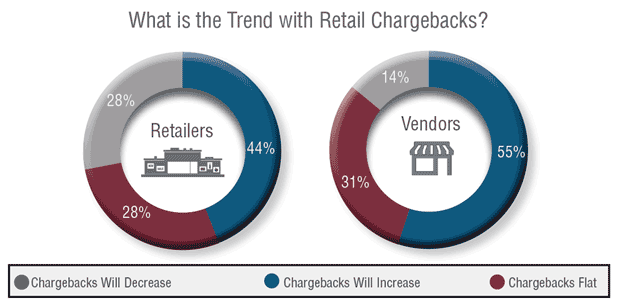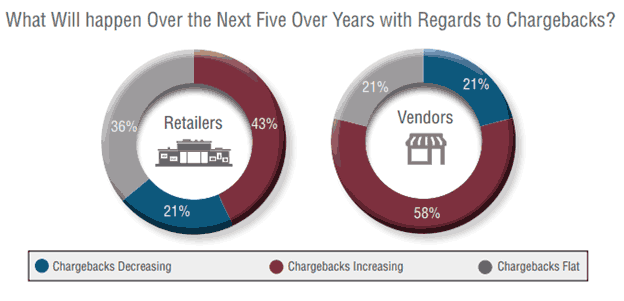Earlier this year, SCDigest release the second in what we hope will be an on-going bi-annual benchmark study on the state of the retailer-vendor supply chain. The excellent – and I mean excellent - full report can be found here: The State of Retailer-Vendor Supply Chain Relationships 2018. Just getting to it now in this column.
Again this year, the key questions are: What is the state of retailer-manufacturer supply chain relationships today? Are they getting better or worse – and why? What are the barriers to higher levels of supply chain collaboration?
Gilmore Says.... |
 |
"The number of deductions year over year has decreased, however the amount we have collected has increased because the violations have hit higher tier dollar amounts," one retailer said. |
 |
What do you say? |
|
| Click here to send us your comments |
| |
|
|
|
The consumer goods to retail supply chain has clearly been the most prominent and quite arguably the most important sector of the supply chain for decades. Just consider how many supply chain
developments and innovations have come from this sector, such as the UPC code, serialized carton bar code labeling, Efficient Consumer Response (ECR), continuous replenishment, Quick Response, Collaborative Planning, Forecasting and Replenishment (CPFR), the EPC RFID tag and more.
Of course, many of the companies most associated with supply chain excellence are either consumer goods manufacturers or retailers, including Walmart, Procter & Gamble, Unilever, Amazon and many others. Many of the initiatives listed above have some level of collaboration between retailers and manufacturers at or near their center.
There is nearly universal agreement that there is significant opportunity for both sides to reduce cost and improve customer service by working more as true supply chain partners in meeting common goals, versus acting as manufacturers and retailers independently pursuing their own strategies and objectives.
In fact, with increasing supply chain efficiency in their own operations, some retailers and especially manufacturers contend that the next generation of supply chain improvements must come from collaborative efforts, working "the seams" of the entire consumer goods to retail value chain.
The amazing thing to me is much the landscape has changed in just two years. To state that the current business environment is a challenging one for both retailers and manufacturers is putting it mildly.
Most - but not all - of that pressure comes from the growth of ecommerce, which continues to rise in the US around 15% every quarter with no end in sight, according to government statistics.
Combine that with clearly changing consumer shopping habits – a Saturday afternoon at the mall just isn't what it used to be for many shoppers – and many brick and mortar retailers are in trouble.
During 2017 we saw complete bankruptcies, in relatively healthy economic times, from chains such as HH Gregg and The Sports Authority, while net store closings were in the 2500 range (8500 closings versus 6000 openings).
It may get worse in 2018, with real estate firm Cushman and Wakefield estimating closings will hit the 12,000 level this year (see Toys R Us).
Of course, much of this can be attributed to Amazon, which continues to grow at faster rates (20+%) than overall ecommerce sales, meaning it is rapidly gaining share. A new term even entered our retail vocabulary as a result of this: being "Amazoned."
But it isn't only retailers that are struggling. Many consumer goods companies, from Mattel to Campbell's Soup, are also under pressure from poor or even negative growth, in part as consumers in the grocery sector move away from traditional consumer packaged goods and the "center aisle" areas of the store towards fresher fare.
All that pressure is leading to change, naturally enough. Nike, for example, says it wants to double the percentage of goods sold on-line directly to customers, and wants to develop real-time visibility into its retail partner inventories so that it can point consumers to the right outlet.
Even more consequentially, both Target and Walmart announced programs in 2017 designed to reduce supply chain variability associated with vendor shipments, notably on-time and fill rate performance. Both retail giants are tightening the requirements and increasing the penalties for underperformance, in moves that could have huge ramifications for the consumer goods to retail supply chain.
The survey was promoted to SCDigest readers, along with support from RVCF (Retail Value Chain Federation), which encouraged its members to participate. In addition, the research was supported by our friends at Compliance Networks, a well-known provider of retail vendor performance management solutions.
All told, SCDigest received survey responses from 44 retailers, about 165 consumer goods manufacturers, and 60 from the "other" category.
Having taken up all this space with an admittedly lengthy intro, I am going to this week just give some highlights of the data relative to the controversial subject of retail chargebacks – the fines retailers impose on vendors for failure to meet various requirements relative to shipments, from labeling issues to late or partial deliveries. In a sense, chargebacks are a leading indicator on the state of the vendor to retail supply chain, across several dimensions that should be clear.
Again this year, we asked both retailers and vendors for their views on the topic, and the results and comments were quite interesting. As shown in the chart below, 28% of retailers say their chargeback levels are growing, whereas vendors see things a bit differently, with 55% indicating they are seeing rising chargebacks.

We're not quite sure how to reconcile those two data points. Regardless, more on both sides say chargebacks are rising than in the previous study, where 36% of retailers and 51% of vendors saw chargebacks levels increasing.
The comments from retailers and vendors on this topic were quite interesting.
"The number of deductions year over year has decreased, however the amount we have collected has increased because the violations have hit higher tier dollar amounts," one retailer said.
On the vendor side, one noted that "Our chargeback levels are rising due to changes in retailer requirements plus internal manual efforts to be compliant, which results in human error. Also, retailers are becoming less willing to bend when requesting leniency for one-time violations."
There are many more interesting comments in the full report.
What's more, both retailers and vendors believe chargebacks are going to head still higher. As can be seen in the chart below, 43% of retailers and 58% or vendors expect chargeback levels to rise, with only 21% of each group predicting chargeback levels will decline. In fact, slightly higher percentages of each group expect chargeback levels to rise in this study than in the previous study, in which 33% of retailers and 52% of vendors predicted chargeback levels would rise. It looks like from our current data that they were right.

"Over the past 18 months we have become more attuned to identifying and reporting compliance errors. In the past many errors would be corrected without being reported. We expect this trend to continue over the next 2-3 years," one retailer noted.
Added one manufacturer: "We need to be smarter to understand the requirements and incorporate the strictest rules from all of our retailers into the general rules of our company."
Very interesting. I am out of space. More in part 2 next week. Full report here. Would love to hear your comments on retail-vendor relationships, chargebacks and more.
What's your view on the state of retail-vendor relations 2018? How are macro-trends impacting that? What are your thougts on chagebacks? Let us know your thought at the Feedback section below.
Your Comments/Feedback
|